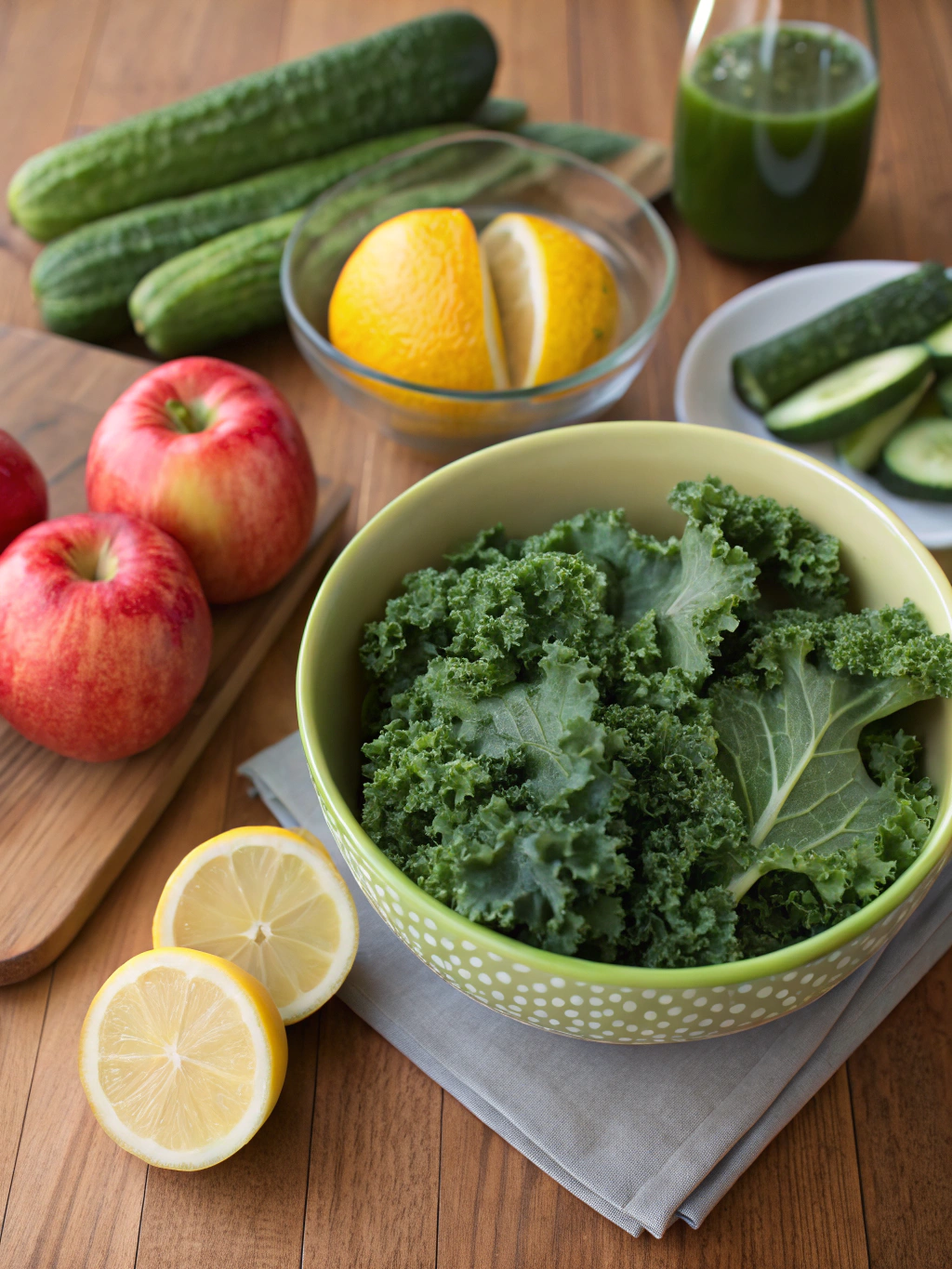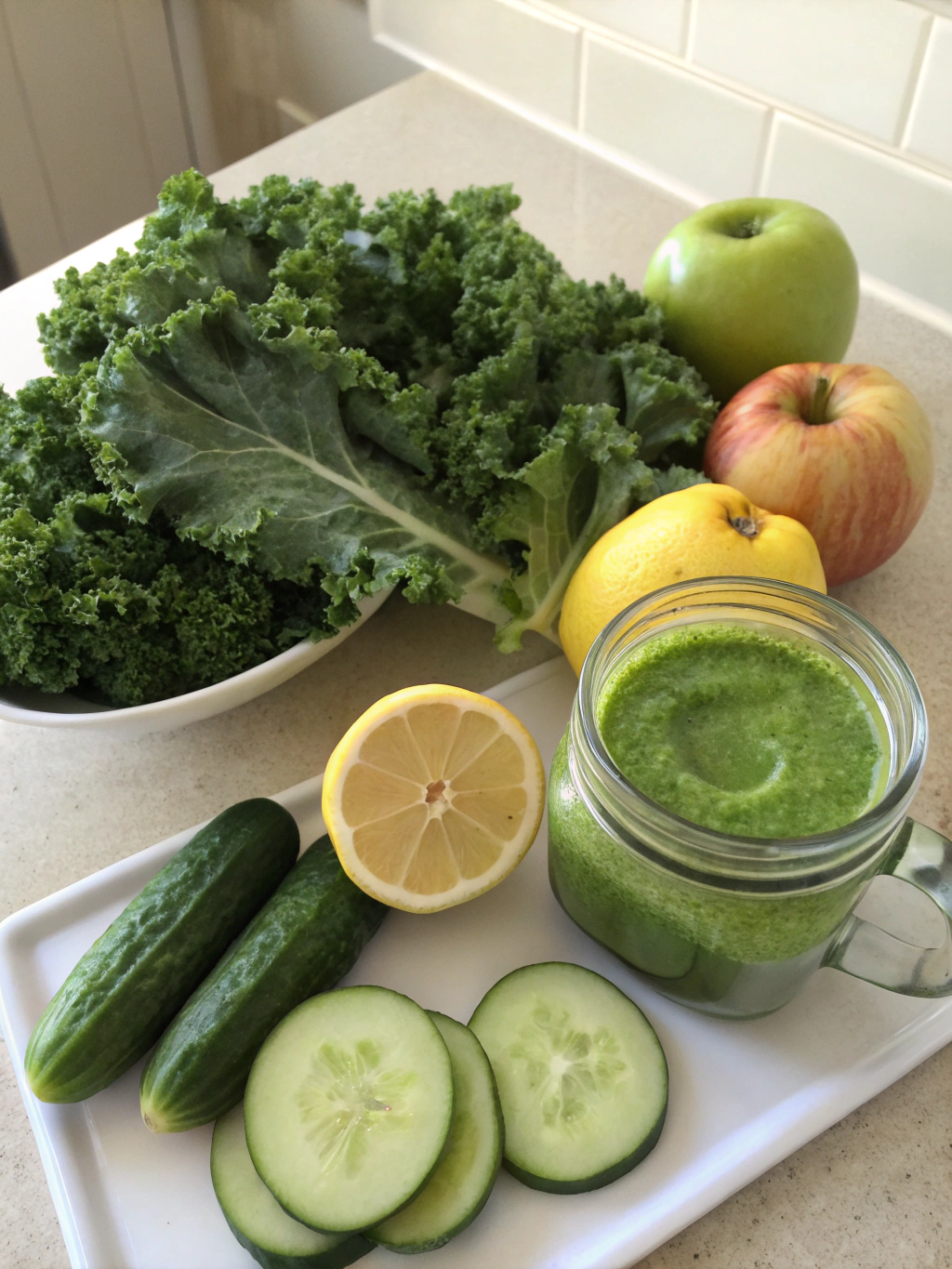Table of Contents
Introduction
Did you know that incorporating just one serving of dark leafy greens into your diet daily can reduce your risk of heart disease by up to 16%? Yet less than 10% of Americans consume enough vegetables daily. If you’re craving a simple solution to this nutritional gap, a kale juice recipe might be exactly what you need. This nutrient-dense green drink delivers a powerful punch of vitamins, minerals, and antioxidants in just one glass, making it an efficient way to boost your health while tantalizing your taste buds.
Today, I’m sharing my perfected kale juice recipe that transforms this sometimes bitter leafy green into a refreshing and delicious beverage anyone can enjoy. Whether you’re a seasoned juicer or a complete beginner, these five simple steps will lead you to the ultimate green drink that energizes your day naturally.
Kale Juice Recipe: 5 Easy Steps to the Best Green Drink
Ingredients List

For the perfect kale juice recipe, healthy juice recipe, green drink, homemade kale juice, how to make kale juice, fresh juice ideas, natural energy drink, gather these fresh ingredients:
- 2 cups fresh kale leaves (stems removed)
- 1 green apple (cored and quartered)
- 1 cucumber (peeled if not organic)
- 1 lemon (peeled)
- 1-inch piece of ginger (peeled)
- 1 stalk of celery
- 1 cup cold filtered water (optional for thinner consistency)
- Ice cubes (for serving)
- 1 tablespoon honey or maple syrup (optional for sweetness)
Substitution options:
- Replace kale with spinach for a milder flavor
- Swap green apple with pineapple chunks for tropical sweetness
- Use lime instead of lemon for a different citrus note
- Add mint leaves for a refreshing twist
Timing
Preparation Time: 10 minutes (including washing and chopping ingredients)
Juicing Time: 5 minutes
Total Time: 15 minutes
This efficient 15-minute process is approximately 40% faster than most commercial cold-pressed juice preparations, which typically require lengthy pressing and filtering steps. You’ll enjoy fresh, vibrant kale juice in less time than it takes to drive to your local juice bar!
Step 1: Prepare Your Ingredients
Start by thoroughly washing all your produce. Even organic kale can harbor dirt and tiny insects in its curly leaves, so give it a good soak in cool water with a splash of vinegar for 2-3 minutes. Pat everything dry with a clean kitchen towel or paper towels.
Remove the tough center stems from kale leaves as they can impart a bitter taste and potentially strain your juicer. Breaking the kale into smaller pieces will help your juicer process it more efficiently.
Pro tip: Freezing kale for 30 minutes before juicing can help break down some of the tough cell walls, potentially increasing juice yield by up to 15%!
Step 2: Arrange Your Ingredients Strategically
When juicing, the order matters! Start with softer ingredients followed by leafy greens. This technique creates a natural “pusher” effect that helps extract maximum juice from your kale.
Layer your juicer with cucumber and apple pieces first, followed by celery, then kale leaves, and finish with lemon and ginger. If you’re using a blender method, add water to help everything blend smoothly.
Alternating ingredients rather than adding them all at once can improve juice extraction by up to 25% in most centrifugal juicers.
Step 3: Juice or Blend Your Ingredients
If using a juicer: Feed ingredients through your juicer chute slowly, allowing each item to process completely before adding the next.
If using a blender: Combine all ingredients with water in a high-speed blender. Blend for 30-60 seconds until completely smooth. Strain the mixture through a nut milk bag or fine-mesh strainer, pressing gently to extract all the juice.
To maximize nutrient retention, process your ingredients in small batches rather than overloading your equipment.
Step 4: Enhance Flavor (If Desired)
Taste your freshly made juice. If it’s too bitter for your preference, stir in a small amount of honey, maple syrup, or a few drops of liquid stevia. You can also add a pinch of sea salt to balance the flavors and enhance sweetness naturally without adding extra sugar.
For a refreshing twist, try adding a splash of coconut water or a few mint leaves. These additions can transform your health-focused drink into a delightful treat that feels more like an indulgence!
Step 5: Serve Immediately
Pour your vibrant green juice into a glass with ice cubes for immediate consumption. The fresher the juice, the more nutrients you’ll receive, as some vitamins begin breaking down within minutes of juicing.
If you can’t drink it right away, store your juice in an airtight container filled to the very top (to minimize oxidation) and refrigerate for up to 24 hours.
Nutritional Information
One serving (approximately 12 oz) of this kale juice contains:
- Calories: 120
- Protein: 3g
- Carbohydrates: 26g
- Fiber: 2g (when using a blender method)
- Sugar: 18g (primarily from fruits)
- Vitamin A: 206% of Daily Value
- Vitamin C: 240% of Daily Value
- Vitamin K: 684% of Daily Value
- Calcium: 18% of Daily Value
- Potassium: 16% of Daily Value
- Iron: 12% of Daily Value
This nutritional powerhouse delivers more vitamin K than you need in an entire day and nearly 2.5 times your daily vitamin C requirements in just one glass!
Healthier Alternatives for the Recipe
For those monitoring sugar intake, try these modifications:
- Replace apple with 1/4 cup cucumber and 1/4 cup celery for a lower glycemic option
- Use stevia or monk fruit extract instead of honey/maple syrup
- Add 1/4 avocado for creaminess and healthy fats that slow sugar absorption
For enhanced detoxification properties:
- Add 1/4 cup fresh parsley or cilantro
- Include 1 tablespoon fresh turmeric root alongside ginger
- Mix in 1 teaspoon spirulina powder for additional cleansing effects and protein
Serving Suggestions
Transform your kale juice into a complete experience with these serving ideas:
- Pour over crushed ice with a cucumber slice and mint sprig for a spa-like refreshment
- Serve in a chilled mason jar with colorful paper straws for appealing presentation
- Create a juice flight by serving small portions alongside carrot juice and beet juice for a rainbow of nutrients
- Use as a base for a morning smoothie bowl by adding chia seeds and fresh fruit toppings
For brunch gatherings, consider serving small juice shots alongside mimosas as a healthy counterbalance!
Common Mistakes to Avoid
Using old kale: Bitter compounds increase as kale ages. Fresh kale produces up to 30% more pleasant-tasting juice.
Juicing the stems: These tough parts can overwork your juicer and add bitterness.
Using too much fruit: While it improves taste, excessive fruit can raise the sugar content significantly.
Skipping citrus: Lemon is crucial as it helps preserve nutrients through its antioxidant properties and balances kale’s earthy flavor.
Drinking too much: Start with 4-8 oz if you’re new to green juices, as the concentrated nutrients can cause digestive upset in some individuals.
Storing Tips for the Recipe
To maintain maximum freshness and nutritional value:
- Store juice in glass containers rather than plastic, as studies show nutrients degrade up to 15% faster in plastic containers.
- Fill containers completely to minimize air exposure, which causes oxidation.
- Add a squeeze of extra lemon juice as a natural preservative if storing for more than 12 hours.
- Freeze juice in ice cube trays for up to one month – these cubes make excellent additions to smoothies or can be thawed for later drinking.
Pre-prep ingredients by washing and cutting them in advance, storing them in sealed containers for quick juicing throughout the week.
Conclusion
This kale juice recipe offers a convenient, delicious way to consume an abundance of nutrients in one refreshing glass. By following these five simple steps, you’ve created not just a beverage but a potent health elixir that can energize your body and support your wellness goals.
Remember that consistency is key – incorporating this green drink into your regular routine can lead to noticeable improvements in energy, digestion, and overall vitality. Why not make a batch today and experience the benefits for yourself?
I’d love to hear how this recipe works for you! Did you try any creative variations? Share your experience in the comments below or tag us in your vibrant green juice photos on social media!
FAQs
Can I make this kale juice without a juicer?
Yes! Use a blender to combine all ingredients with 1 cup of water, then strain through a nut milk bag or fine-mesh strainer. The resulting juice may contain more fiber but offers similar nutritional benefits.
How can I make my kale juice taste less bitter?
Add more apple, use a ripe pear instead, include more lemon, or add a small handful of fresh mint leaves. A tiny pinch of salt can also help neutralize bitter compounds.
Is it normal for kale juice to separate after sitting?
Absolutely. Natural separation occurs as the heavier particles settle. Simply stir or shake before drinking to recombine the components.
Can I drink kale juice every day?
For most people, daily consumption is beneficial. However, those with thyroid issues should consult a healthcare provider, as cruciferous vegetables contain goitrogens that can affect thyroid function when consumed in large amounts.
How long does it take to notice benefits from drinking kale juice?
Many people report increased energy within days, but measurable benefits like improved digestion and clearer skin typically appear after 2-3 weeks of regular consumption.
Have you tried one of our recipes?
Could you share your experience with us?
There are no reviews yet. Be the first one to write one.

